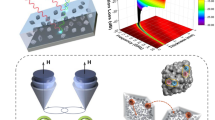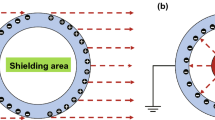Abstract
Electromagnetic (EM) metamaterials with negative permittivity and permeability can be used to develop advanced EM devices such as perfect EM wave absorbers and frequency selective microwave shields. One of the approaches has been to apply artificial periodic structures such as printed metal patterns or strip lines. However, granular composite materials embedded with metallic and/or magnetic particles can also be utilized to develop EM metamaterials. In this paper, we studied the effect of particle shape on the electrical conductivity and the relative complex permittivity spectra of Cu granular composite materials in the radio-frequency (RF) to the microwave frequency range. Three types of Cu composites containing spherical, flaky, and arborized particles were prepared, and their electrical conductivity and relative complex permittivity were measured. An insulator-to-metal transition was observed at the percolation threshold φc in all composites; the φc of the flaky and arborized particle composites was lower than that of the spherical particle composites. In composites above φc, a negative permittivity spectrum was observed regardless of the particle shape. The negative permittivity spectra of the percolated Cu particle composites were analysed using the Drude model. It was shown that the plasma frequency at which the real part of the permittivity changes from negative to positive depends not only on the particle content but also on the particle shape. Thus, our study facilitates the adjustment of the negative permittivity and enhancement in the electromagnetic properties of EM metamaterials, which can lead to the development of advanced EM devices.






Similar content being viewed by others
Availability of data and material
The datasets generated during and/or analysed during the current study are available from the corresponding author on reasonable request.
References
N. Landy, S. Sajuyigbe, U. Mock, D. Smith, W. Padilla, Phys. Rev. Lett. 100, 207402 (2008). https://doi.org/10.1103/PhysRevLett.100.207402
T. Tsutaoka, K. Hatakeyama, IEICE Trans. Commun. 93(7), 1858–1861 (2010). https://doi.org/10.1587/transcom.E93.B.1858
C.M. Watts, X. Liu, W.J. Padilla, Adv. Mater. 24, 98–120 (2012). https://doi.org/10.1002/adma.201200674
J.B. Pendry, A.J. Holden, D.J. Robbins, W.J. Stewart, J. Phys, J. Phys. Condens. Matter 10, 4785–4809 (1998)
R.A. Shelby, D.R. Smith, S. Schultz, Science 292, 77–79 (2001). https://doi.org/10.1126/science.1058847
S.T. Chui, L.B. Hu, Phys. Rev. B 65, 144407 (2002). https://doi.org/10.1103/PhysRevB.65.144407
T. Tsutaoka, T. Kasagi, S. Yamamoto, K. Hatakeyama, Appl. Phys. Lett. 102, 181904 (2013). https://doi.org/10.1063/1.4804379
D. Estevez, F. Qin, Y. Luo, L. Quan, Y.-W. Mai, L. Panina, H.-X. Peng, Compos. Sci. Technol. 171, 206–217 (2019). https://doi.org/10.1016/j.compscitech.2018.12.016
K. Sun, P. Xie, Z. Wang, T. Su, Q. Shao, J.E. Ryu, X. Zhang, J. Guo, A. Shankar, J. Li, R. Fan, D. Cao, Polymer 125, 50–57 (2017). https://doi.org/10.1016/j.polymer.2017.07.083
T. Kasagi, T. Tsutaoka, K. Hatakeyama, Appl. Phys. Lett. 89, 172502 (2006). https://doi.org/10.1063/1.2198113
C. Mitsumata, S. Tomita, Appl. Phys. Lett. 91, 223104 (2007). https://doi.org/10.1063/1.2816894
T. Kasagi, T. Tsutaoka, K. Hatakeyama, J. Appl. Phys. 116, 153901 (2014). https://doi.org/10.1063/1.4898072
H. Massango, T. Tsutaoka, T. Kasagi, Mater. Res. Exp. 3, 095801 (2016). https://doi.org/10.1088/2053-1591/3/9/095801
Z.-C. Shi, R.-H. Fan, Z.-D. Ahang, L. Qian, M. Gao, M. Zhang, L.-T. Zheng, X.-H. Zhang, L.-W. Yin, Adv. Mater. 23, 2349–2352 (2012). https://doi.org/10.1002/adma.201200157
T. Tsutaoka, K. Fukuyama, H. Kinoshita, T. Kasagi, S. Yamamoto, K. Hatakeyama, Appl. Phys. Lett. 103, 261906 (2013). https://doi.org/10.1063/1.4858976
T. Tsutaoka, H. Massango, T. Kasagi, S. Yamamoto, K. Hatakeyama, Appl. Phys. Lett. 108, 191904 (2016). https://doi.org/10.1063/1.4949560
H. Massango, T. Tsutaoka, T. Kasagi, S. Yamamoto, K. Hatakeyama, J. Magn. Magn. Mater. 442, 403–408 (2017). https://doi.org/10.1016/j.jmmm.2017.07.018
C. Cheng, R. Fan, G. Fan, H. Iu, J. Zhang, J. Shen, Q. Ma, R. Wei, Z. Guo, J. Mater. Chem. C 7, 3160–3167 (2019). https://doi.org/10.1039/c9tc00291j
T. Kasagi, K. Kono, T. Tsutaoka, S. Yamamoto, IEEE Trans. Magn. 55(2), 2800204 (2019). https://doi.org/10.1109/TMAG.2018.2869581
H. Massango, T. Tsutaoka, T. Kasagi, S. Yamamoto, K. Hatakeyama, J. Appl. Phys. 121, 1039029 (2017). https://doi.org/10.1063/1.4977997
Y. An, J. Qin, K. Sun, J. Xin, X. Li, X. Wu, W. Zhang, R. Fan, J. Mater. Sci.: Mater. Electron. 32, 11588–11592 (2021). https://doi.org/10.1007/s10854-021-05763-3
S. Yoshida, M. Sato, E. Sugawara, Y. Shimada, J. Appl. Phys. 85(8), 4636–4638 (1999). https://doi.org/10.1063/1.370432
T. Kasagi, T. Tsutaoka, K. Hatakeyama, IEEE Trans. Magn. 35, 3424–3426 (1999)
Q. Xue, Eur. Poly. J. 40, 323–327 (2004). https://doi.org/10.1016/j.eurpolymj.2003.10.011
H. Kura, K. Hata, T. Oikawa, M. Takahashi, T. Ogawa, Scr. Mater. 76, 65–68 (2014). https://doi.org/10.1016/j.scriptamat.2013.12.018
T. Kasagi, H. Massango, T. Tsutaoka, S. Ymamoto, K. Hatakeyama, Mater. Res. Exp. 5, 036107 (2018). https://doi.org/10.1088/2053-1591/aab4de
J. Baker-Jarvis, E.J. Vanzura, W.A. Kissick, IEEE Trans. Microw. Theory Tech. 38, 1096–1103 (1990). https://doi.org/10.1109/22.57336
A.M. Nicolson, G.F. Ross, IEEE Trans. Instrum. Meas. 19(4), 377–382 (1970). https://doi.org/10.1109/TIM.1970.4313932
W.B. Weir, Proc. IEEE 62(1), 33–36 (1974). https://doi.org/10.1109/PROC.1974.9382
S.R. Elliott, Adv. Phys. 36, 135–218 (1987). https://doi.org/10.1080/00018738700101971
A. Bose, S. Basu, S. Banerjee, D. Chakravorty, J. Appl. Phys. 98, 074307 (2005). https://doi.org/10.1063/1.2084311
Acknowledgements
This work was supported by JSPS KAKENHI Grant Number JP20K06758.
Funding
This work was supported by JSPS KAKENHI (Grant Number JP20K06758).
Author information
Authors and Affiliations
Contributions
TT designed research; TT and SY performed the experiments: TT and SY analysed the data; TT and SY wrote the paper.
Corresponding author
Ethics declarations
Conflict of interest
The authors declare no conflicts in interests.
Additional information
Publisher's Note
Springer Nature remains neutral with regard to jurisdictional claims in published maps and institutional affiliations.
Rights and permissions
About this article
Cite this article
Kasagi, T., Yamamoto, S. Effect of particle shape on electrical conductivity and negative permittivity spectra of Cu granular composite materials. J Mater Sci: Mater Electron 33, 4974–4983 (2022). https://doi.org/10.1007/s10854-021-07686-5
Received:
Accepted:
Published:
Issue Date:
DOI: https://doi.org/10.1007/s10854-021-07686-5




